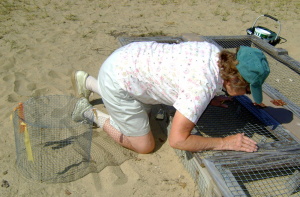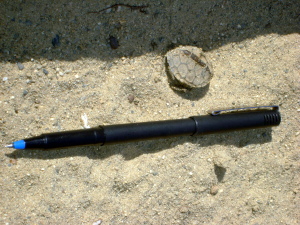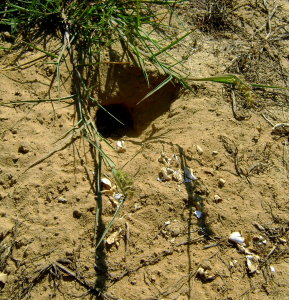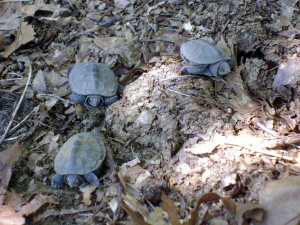Turtles from the Dust: Endangered Terrapins in Rhode Island
The sand is fine grained and the sun is hot. Hundred Acre Cove in Barrington is just a few hundred yards away, but at the moment, there isn’t a shred of the cool breezes usually associated with being by the water. There are only scrub pines, weedy grasses, and dust. Lots of dust.
Charlotte Sornborger carries a basket containing an empty green and white striped Newport Creamery plastic tub. She wears a hat and sunglasses against the brilliant sunshine as she approaches the area. Amid the scrubby grasses are a number of round, wire mesh objects stuck in the sand. They appear to be the remains of someone’s quixotic attempt to grow vegetables. In fact, the circular structures are guardians of a kind of buried treasure: the eggs of the diamondback terrapin turtle.

Charlotte Sornborger, of the Barrington Land Conservation Trust, places young terrapins in a container she’ll use to move them to a nearby location.
The terrapin is an endangered species here in Rhode Island, and a species of concern nationally. At eight to ten inches in length for females and a mere four to six for the males, these diminutive creatures are the only turtle species in the US that live in brackish waters (brackish water is a mix of salt and fresh water). They are gray, and the carapace is comprised of a series of diamond shaped segments that give the turtle its name. The Barrington population has been monitored for 25 years, though there has also been work done in the South County area to track them.
The nests in Barrington are part of the Doug Rayner Wildlife Refuge, a 33-acre parcel under the care of the Barrington Land Conservation Trust (BLCT). The wire structures are excluders, and the sides are dug several inches into the sand to discourage predators. Charlotte’s visit today is one of the BLCT’s twice daily schedule of nest maintenance that happens all summer long, and is part of the year-round life cycle of the terrapin.
Sornborger explains that this population of terrapin turtles spends their winter buried in the mud of Hundred Acre Cove, in order to maintain a constant body temperature and not freeze. Females may store the sperm of the previous summer’s mating season over the winter. By late April or early May, the turtles begin to surface in order to bask in the sun and slowly shake off their winter torpor. At the start of June, the journey up the banks will begin as the females return to what is likely the same area they have nested for generations. The climb of about 25 yards for an animal eight inches long must seem mountainous, but climb they do until they find just the right spot in the sandy surface above the water’s edge, where they will dig a hole in the sand and deposit their eggs. They will then return to the water, leaving the eggs to develop and hatch without any further care. The nesting process transpires in just one day, which has made locating major nesting areas in South County a struggle, according to Wildlife Ecology Prof. Peter Paton of the University of Rhode Island.

Sornborger checks the large excluder for newly hatched turtles. To the left is a small (unused) excluder, and the basket she carries on her rounds is in the upper right.
“We have no known concentration of nesting terrapins (in the South County area), as they do at Hundred Acre Cove,” Paton explains. “There were a couple of young reported last year, and a couple of nests were discovered around Winnepaug Pond (near Misquamicut) this year. We’ve recorded seven individuals there. It’s hard to say why the population is so different on this side of the bay. There’s some indication that they were more common at the turn of the century. My guess is that there is a population of less than 50 adults, which is at the high end for numbers.
“The trouble is that they come in for a day, lay their eggs, and leave, so unless you’re there on that one day when they come up, you’re not going to see them.” Paton notes that there was a kayak survey done last year. “There’s still lots of interest in the terrapins, but there isn’t a conservation strategy for South County yet.”
Lucky for the Barrington terrapins, BLCT has a crew of ten volunteers who monitor the nesting process. Some nests will have the excluder placed around them, offering some protection from predators like skunks, fox, and coyotes. “Over the years, the coyotes have keyed in on this area as a good place to get a meal,” Sornborger explains. “As that happened, they pretty much drove out most of the skunks and fox. You can see all these areas where the coyote pups are learning to dig for nests,” she says, pointing to the dozens of divots in the sand. Most small holes are where the coyotes came up empty, but here and there the leathery shells of the terrapin eggs are scattered at the edge of the divot, showing that the searches were not all in vain.
Every few excluders yields a tiny turtle, hatched only since this morning, when the nests were last checked. The gray creatures are about 1 ½” long, and may have the remains of the shell still attached to them. Sornborger picks each one up and places them in the plastic tub she carries in her basket. After checking all the smaller excluders, she makes her way to a larger structure. It measures perhaps 18 feet, is framed with wood, and built close to the ground to allow placement of eggs in the sand. Eggs collected from the area were carefully placed in containers and moved to this larger, stronger excluder. As they were moved, care was taken to collect the eggs in specific order. The sex of the turtles is determined by the amount of heat in the nest; eggs near the surface will receive more heat from the sun, and will emerge as females. Those in the slightly cooler area near the bottom will be males. Each displaced nest will be recorded for date and number of eggs, then replaced in exactly the same manner in which they were taken. Thought the typical nest contains eight to ten eggs, one in this excluder contains 27, the largest number Sornborger has witnessed in 25 years of care.
This afternoon’s visit has yielded six young. After the results have been logged in, Charlotte Sornborger carries them down the same bank that their mothers trudged up several months before. The bank is scattered with shrubs and trees, the ground littered with leaves. Twenty feet from the water’s edge, she stops, sits, and removes each turtle. She carefully places each one on the leaf litter. They look like tiny children’s toys at first, holding still while their tiny brains gather their bearings. Gradually, they begin to move, eventually working their way under the leaves, where they will spend the winter.

The afternoon rounds complete, Charlotte Sornborger drives through clouds of dust on the dirt road leading out of Rayner Wildlife Refuge. The expedition has been a profitable one. As of that visit, nearly 400 turtles had hatched, and the season was not yet over. The life expectancy of the terrapin turtle is roughly 40 years, so for some this will be the start of a long life. But if the notion of 400 turtles wandering amid the leaf litter seems like a population explosion, the truth is that few will live to that ripe old age. “Out of the ones we gather this year, about one per cent will live to maturity. If we’re lucky.”









